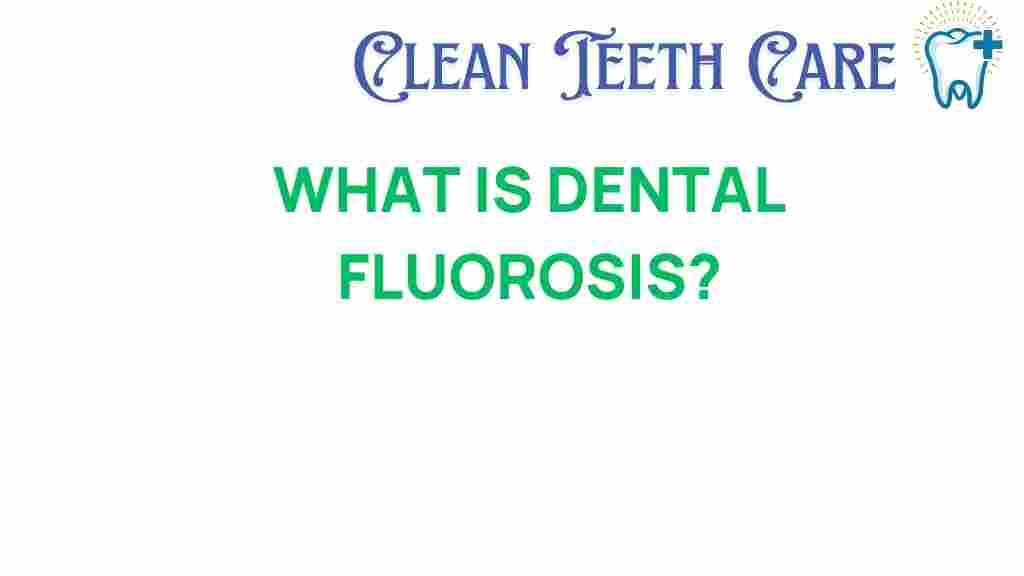Unveiling Dental Fluorosis: The Hidden Consequences of Excess Fluoride
Dental fluorosis is a condition that arises from excessive fluoride exposure during the formative years of a child’s dental development. While fluoride is widely recognized for its benefits in preventing cavities and enhancing oral health, its overconsumption can lead to unforeseen consequences, primarily manifested as teeth discoloration and enamel defects. Understanding dental fluorosis is essential for parents, caregivers, and dental professionals to ensure optimal dental care for children.
What is Dental Fluorosis?
Dental fluorosis is a cosmetic condition that affects the appearance of teeth. It occurs when there is an overexposure to fluoride during the early years of tooth development, typically up to the age of eight. The condition can lead to changes in the color, texture, and overall integrity of the enamel.
Causes of Dental Fluorosis
The primary cause of dental fluorosis is excessive intake of fluoride from various sources, which may include:
- Fluoridated drinking water
- Fluoride supplements
- Fluoride toothpaste
- Dental treatments that involve fluoride
- Environmental exposure (industrial or agricultural)
Understanding Fluoride Exposure
Fluoride is a mineral that is naturally found in soil, water, and various foods. When consumed in appropriate amounts, fluoride strengthens teeth and helps prevent decay. However, excessive fluoride exposure can disrupt the normal development of enamel, leading to dental fluorosis. The risk of developing this condition increases when children ingest too much fluoride during the years when their teeth are forming.
Symptoms of Dental Fluorosis
Symptoms of dental fluorosis vary in severity and can range from mild to severe. Common signs include:
- White spots or streaks on the teeth
- Brown or black discoloration
- Surface pitting or roughness on the enamel
- Increased sensitivity to hot or cold
It’s important to note that while dental fluorosis affects the cosmetic appearance of teeth, it typically does not impact their functionality or overall oral health.
Impact of Dental Fluorosis on Oral Health
The impact of dental fluorosis on oral health goes beyond mere appearance. While fluorosis may not directly cause dental decay, it can lead to various complications, such as:
- Increased risk of cavities in severely affected teeth due to enamel erosion.
- Difficulty in maintaining oral hygiene due to rough enamel surfaces.
- Psychological effects, such as low self-esteem or anxiety related to dental appearance.
Prevention of Dental Fluorosis
Preventing dental fluorosis revolves around managing fluoride exposure during childhood. Here are steps to minimize the risk:
- Monitor Fluoride Intake: Be aware of all sources of fluoride, including drinking water, food, and dental products.
- Use Fluoride Toothpaste Wisely: For children under the age of three, use a smear of fluoride toothpaste. For those aged three to six, a pea-sized amount is sufficient.
- Limit Fluoride Supplements: Only administer fluoride supplements if prescribed by a dentist or pediatrician, particularly if your water supply is not fluoridated.
- Educate Children: Teach children not to swallow toothpaste and to rinse their mouths after brushing.
- Regular Dental Check-ups: Regular visits to a dentist can help monitor fluoride exposure and catch any early signs of fluorosis.
Dental Care and Child Development
The health of a child’s teeth is integral to their overall development. Proper dental care practices can prevent conditions like dental fluorosis and promote healthy habits that last a lifetime. Some effective practices include:
- Establishing a Routine: Encourage brushing twice daily and flossing regularly.
- Healthy Diet: A balanced diet low in sugary foods can help prevent cavities and support enamel health.
- Fluoride Varnish Treatments: Discuss the application of fluoride varnish with your dentist to strengthen enamel while minimizing the risk of fluorosis.
Dental Treatments for Fluorosis
If dental fluorosis occurs, various dental treatments can improve the appearance of affected teeth:
- Teeth Whitening: Professional whitening treatments can help reduce the appearance of discoloration.
- Bonding: Composite resin can be applied to cover discolored areas.
- Veneers: Porcelain veneers can provide a more uniform appearance for severely affected teeth.
- Microabrasion: This technique can remove superficial discoloration and improve the overall look of the teeth.
Troubleshooting Tips for Dental Fluorosis
If you suspect that your child may be suffering from dental fluorosis, consider the following troubleshooting tips:
- Consult a Dentist: Schedule an appointment to evaluate the extent of fluorosis and discuss potential treatment options.
- Review Fluoride Sources: Assess all sources of fluoride in your child’s diet and oral hygiene routine.
- Implement Preventive Measures: Adjust fluoride usage according to professional recommendations.
- Educate Yourself: Stay informed about fluoride guidelines and recommendations from reputable sources, such as the American Dental Association.
Conclusion
Dental fluorosis is a condition that highlights the importance of balancing fluoride exposure for oral health. While fluoride is beneficial in preventing cavities, excessive intake can lead to dental fluorosis, affecting the aesthetic and psychological well-being of individuals, particularly children. By understanding the causes, symptoms, and prevention strategies, parents and caregivers can help safeguard their children from the adverse effects of fluoride. Maintaining regular dental care, monitoring fluoride consumption, and consulting with dental professionals are crucial steps in ensuring a healthy dental future.
For more information on maintaining optimal oral health and navigating dental treatments, visit our Dental Care Resources.
This article is in the category Conditions and created by CleanTeethCare Team

1 thought on “Unveiling Dental Fluorosis: The Hidden Consequences of Excess Fluoride”